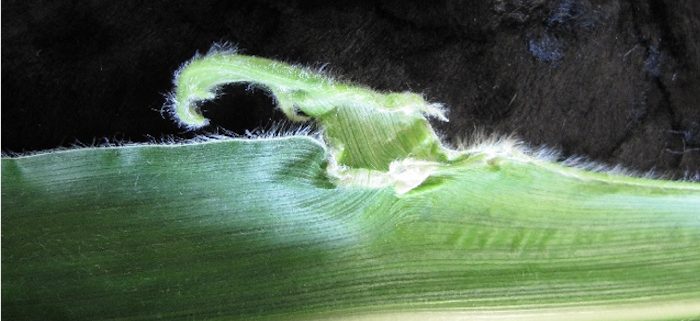Cytokinin can reprogram leaf patterning
Muszynski et al. explore the mechanisms controlling tissue organization in developing leaves.
Plant Cell https://doi.org/10.1105/tpc.19.00677
By Michael G. Muszynski, University of Hawaiʻi – Mānoa
Background: Leaves are responsible for capturing sunlight and carbon dioxide that provide food for the growing plant and also the calories we eat. To function properly, leaves must develop into the correct size and shape. Grass leaves have a particular shape defined by the base-to-tip arrangement of four different tissues in the order sheath, auricle, ligule, and blade. This organization is the same for all leaves and it occurs very early in leaf development. Despite the importance of this pattern on leaf function, only a few genes have been identified that influence this base-to-tip organization, with some known to affect the accumulation of plant hormones like cytokinin and auxin.
Question: What molecular mechanisms are responsible for controlling the base-to-tip organization of different tissue in the developing leaf?
Findings: By studying a maize mutant whose leaves have sheath, auricle, and ligule tissue growing from the wrong place in the blade, we identified the underlying gene as Zea mays Histidine Kinase1 (ZmHK1), a receptor for the plant hormone cytokinin (CK). Mutant versions of ZmHK1 that produced altered leaf organization have amino acid changes in a region of the receptor where CK binds. These changes affect hormone binding affinity and result in a mutant receptor that can signal in the absence of CK. We can reproduce the ZmHK1 mutant effects by treating normal maize plants with extra CK, confirming our molecular results. Additional expression and double mutant analyses indicated the ZmHK1 mutant appears to hypersignal CK, suggesting this classic plant hormone can influence the arrangement of tissue in developing leaves.
Next steps: Our results indicate cytokinin can reprogram the spatial organization of tissue during leaf development. The next questions to ask are what genes are operating downstream of the cytokinin signal and what pathways do they control. Developing a more detailed understanding of the genetic mechanisms that influence leaf patterning are our next goals.
Michael G. Muszynski, Lindsay Moss-Taylor, Sivanandan Chudalayandi, James Cahill, Angel R. Del Valle-Echevarria, Ignacio Alvarez-Castro, Abby Petefish, Hitoshi Sakakibara, Dmitry M. Krivosheev, Sergey N. Lomin, Georgy A. Romanov, Subbiah Thamotharan, Thao Dam, Bailin Li, and Norbert Brugière. (2020). The Maize Hairy Sheath Frayed1 (Hsf1) Mutation Alters Leaf Patterning Through Increased Cytokinin Signaling. Plant Cell; DOI: https://doi.org/10.1105/tpc.19.00677




